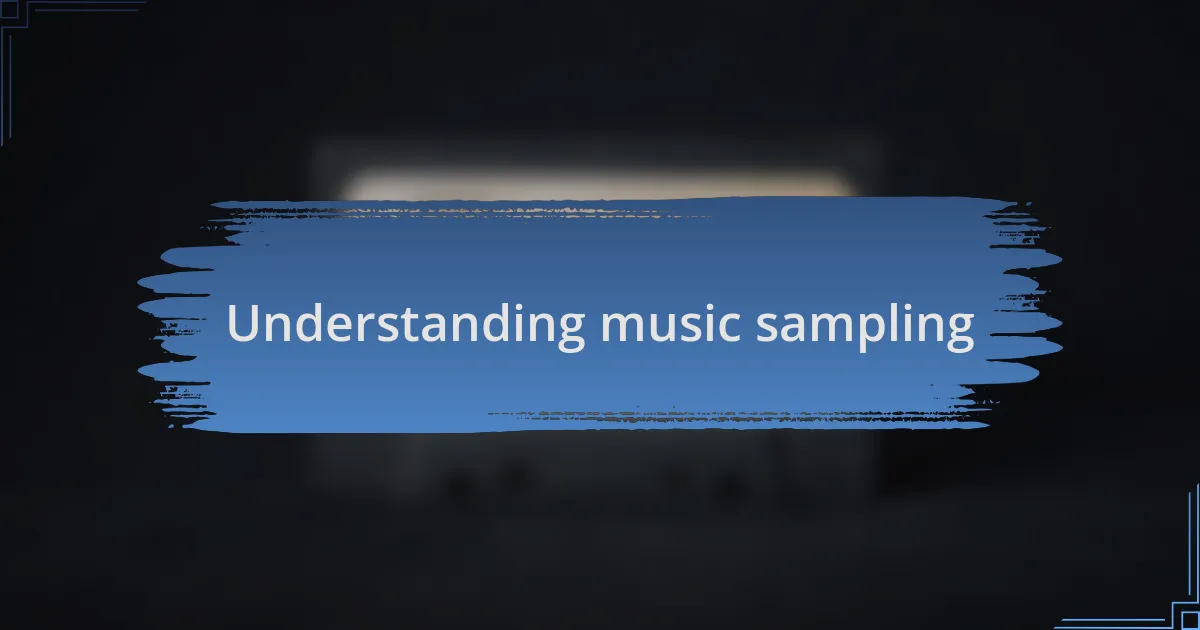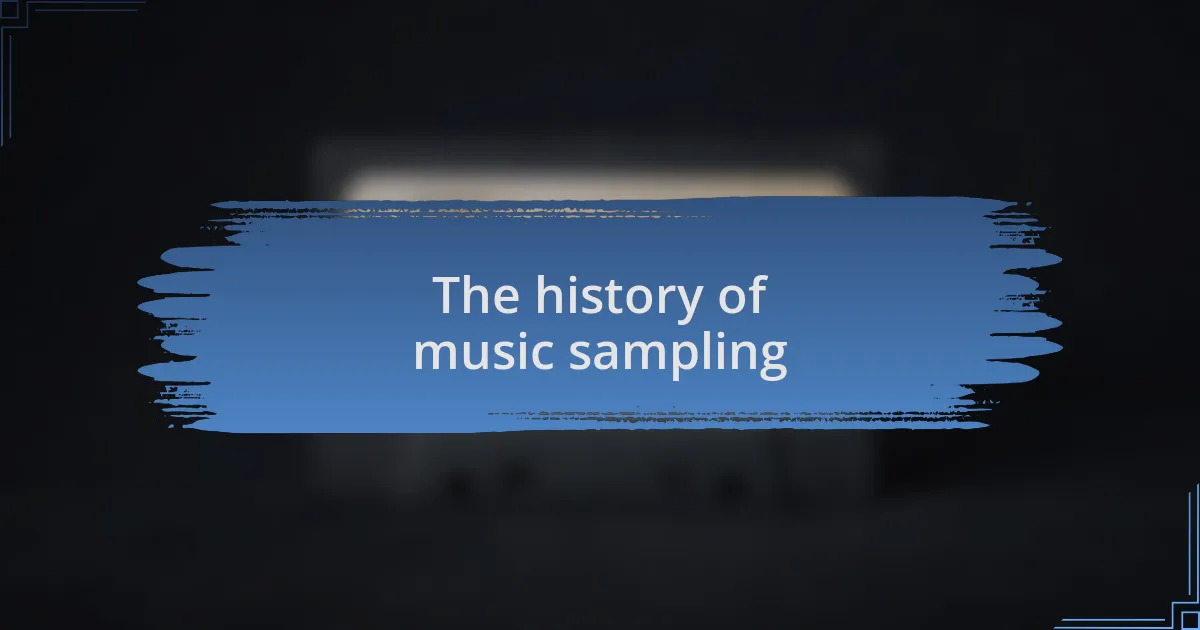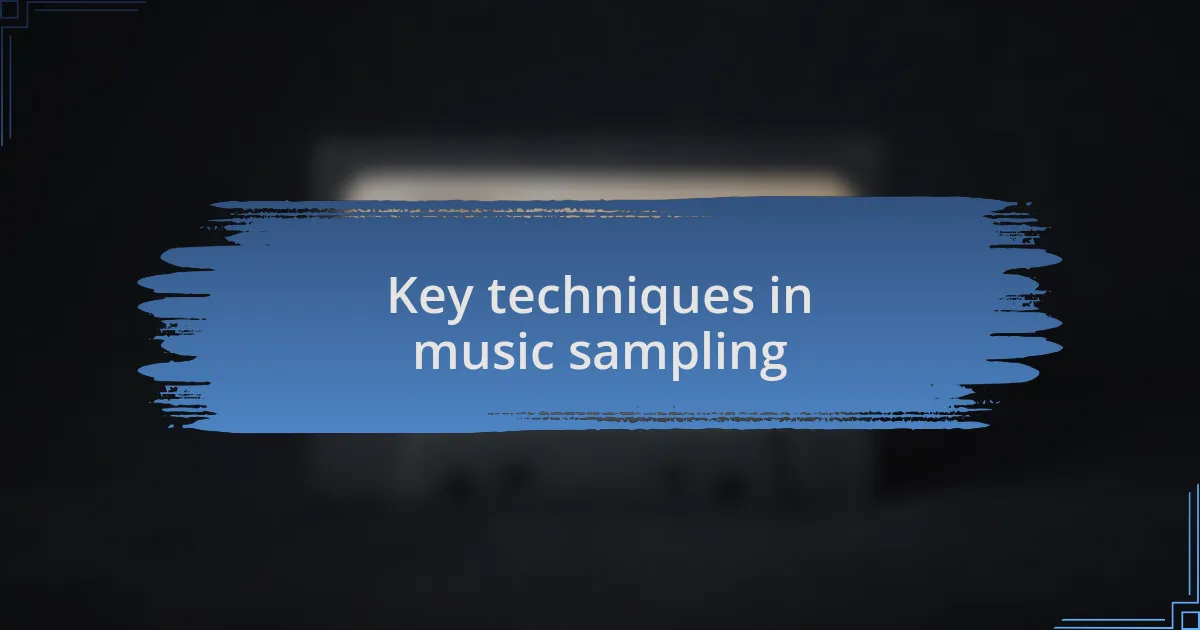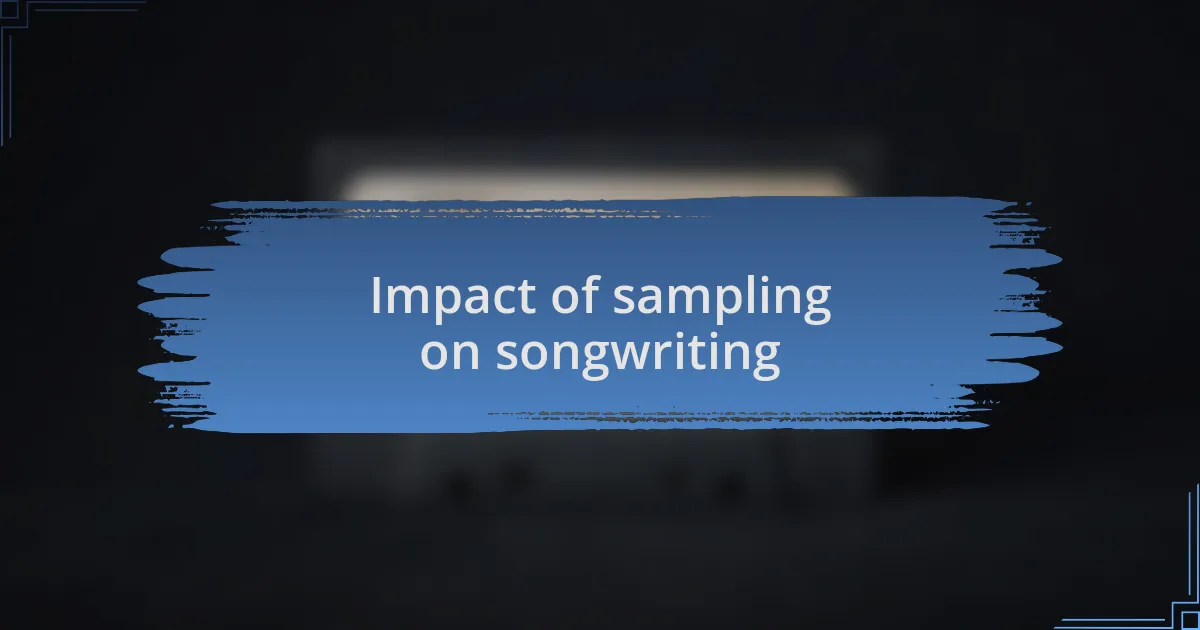Key takeaways:
- Music sampling began in the late 1960s with pioneers like DJ Kool Herc, evolving significantly with the introduction of technology in the 1980s.
- Sampling has transformed songwriting, allowing artists to blend genres and create narratives that resonate across generations.
- The legal and ethical dimensions of sampling have sparked ongoing debates about originality and respect for original creators.
- Future trends may include increased accessibility through technology, AI-assisted creativity, and collaborations between established and emerging artists.

Understanding music sampling
Music sampling is a fascinating practice where artists take a portion of a sound recording and incorporate it into a new work. I remember the first time I heard a song that prominently featured a sample; it felt like a light bulb went off. How could reimagining something old breathe new life into a song, making it feel both nostalgic and fresh?
When I think about sampling, I can’t help but feel a deep appreciation for its transformative power. It’s not just about lifting a beat or a melody; it’s about storytelling. I often wonder how artists decide which pieces to sample—what draws them to certain sounds? For me, that blend of old and new creates a conversation across generations, connecting listeners through shared musical heritage.
It’s intriguing to consider the legal and ethical dimensions of sampling as well. I’ve personally experienced moments of frustration when discovering that a song I loved was built upon another artist’s work without proper credit. It raises poignant questions: How do we balance creativity with respect for original creators? In my view, acknowledging the roots of our musical influences is vital, and it enhances the richness of the art form we all cherish.

The history of music sampling
The history of music sampling began in the late 1960s and 1970s with the advent of new technology. Early pioneers like DJ Kool Herc took snippets of funk and soul tracks to create a rhythmic backdrop for hip-hop, sparking a cultural revolution. I can vividly recall how these innovative techniques seemed to break down artistic barriers. It felt like a celebration of creativity, where each artist paid homage to the sounds that shaped them.
As time went on, sampling evolved with advancements in technology. The introduction of the sampler in the 1980s allowed musicians to integrate diverse sonic elements into their compositions effortlessly. I remember being mesmerized by how artists like Public Enemy and the Beastie Boys used samples to create densely layered tracks that felt electric and alive. They made me rethink what a song could be, challenging the very definition of originality in music.
By the 1990s, sampling hit mainstream success, but it also met significant legal scrutiny. Lawsuits over unauthorized samples prompted a shift in how artists approached the practice. I often found myself torn between admiration for the creativity behind a sample and concern over the financial implications for the original creators. It sparked an ongoing dialogue about the boundaries of artistic expression, and I’ll admit, I still ponder where that balance truly lies.

Key techniques in music sampling
When it comes to the techniques of music sampling, one of the most exciting methods is using pitch and tempo manipulation. I remember listening to how artists like Daft Punk took familiar melodies and transformed them into something entirely new by adjusting their pitch and speed. This not only adds a fresh sound but also creates a nostalgic connection for listeners who recognize the original.
Another crucial technique is chopping, where producers take small snippets of a sample and rearrange them to create a completely different rhythm or melody. I’ve been amazed by how J Dilla’s intricate chopping style seems to breathe life into samples, turning them into a potent canvas for his innovative beats. The urgency and movement in his work made me realize that those tiny fragments could evoke powerful emotions when placed together thoughtfully.
Layering is another powerful technique that really captivates me. By stacking multiple samples and sounds, artists can develop rich, complex textures in their music. I’ve often found myself lost in tracks by Kanye West, where the layering creates a tapestry of sound that draws you in. It poses an interesting question: how many layers does it take to truly create a unique sound while still honoring the original? It’s a fine balance, and I think that’s what makes sampling so fascinating.

Impact of sampling on songwriting
Sampling has profoundly reshaped the landscape of songwriting, opening avenues for artists to express their creativity in unique ways. I recall the first time I heard “Viva La Vida” by Coldplay and how the unmistakable influence of past classical baroque elements infused the track with depth and emotion. It made me wonder: could such a modern hit exist without drawing from the rich history of music that came before it?
Through sampling, songwriters can weave stories that resonate across generations. When I hear a familiar riff, it often transports me back to significant moments in my life, creating a personal connection to the new music. This intertextual conversation between old and new not only enriches the listener’s experience but also challenges songwriters to craft innovative narratives layered with meaning.
It’s fascinating to see how sampling encourages collaboration between genres, too. For instance, the way hip-hop artists incorporate elements from rock or jazz broadens the musical palette available to songwriters. I’ve experienced this blend firsthand, attending concerts where artists seamlessly combine diverse influences, and it left me thinking—how much more can sampling evolve in the future as technology advances?

Awards recognizing innovative songwriting

Awards recognizing innovative songwriting
When I think of awards that celebrate innovative songwriting, the Grammys immediately come to mind. They not only recognize commercial success but also give a nod to artistic merit, often honoring tracks that challenge traditional songwriting norms. I remember watching the Grammy Awards and feeling a surge of pride when an unconventional song took home the award, reminding me that creativity often flourishes outside the mainstream.
Another notable mention is the ASCAP Rhythm & Soul Music Awards, which shine a spotlight on songwriters who push the boundaries of genre. In my experience as a music lover, discovering artists celebrated for their unique sound has a profound impact, inspiring emerging songwriters to explore their own innovative ideas. It raises the question: how can we continue to encourage this trend within the industry?
Beyond just the accolades, these awards play an essential role in promoting diverse voices in music. I always feel invigorated when I hear about a newcomer winning an award for their groundbreaking work. It not only validates their efforts but also sends a clear message: innovation in songwriting deserves recognition, and it can come from anywhere.

Future trends in music sampling
As I look ahead to the future of music sampling, I can’t help but think about the increased accessibility of technology for aspiring producers. With affordable software packages and online platforms, it’s now easier than ever for creators to experiment with sampling. I recall my excitement when I first discovered a powerful sampling app; it empowered me to create unique sounds that perfectly captured my artistic vision.
Moreover, I anticipate that the blending of artificial intelligence with music sampling will reshape the landscape. Imagine a future where AI can analyze thousands of tracks and suggest innovative ways to remix them. This brings up an intriguing question: will this technology enhance creativity, or could it stifle originality? Personally, I believe that if used thoughtfully, AI could open doors for fresh, unexplored sounds and styles.
Finally, I see a trend toward greater collaboration between established artists and emerging creators in sampling. These partnerships could lead to the birth of entirely new genres and sounds, fueled by the diverse influences each artist brings. Reflecting on past collaborations that changed my perspective on music, I can’t help but wonder what groundbreaking partnerships await us. How will these evolving dynamics influence the music we hear in the coming years?